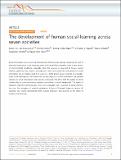Files in this item
The development of human social learning across seven societies
Item metadata
| dc.contributor.author | van Leeuwen, Edwin J. C. | |
| dc.contributor.author | Cohen, Emma | |
| dc.contributor.author | Collier-Baker, Emma | |
| dc.contributor.author | Rapold, Christian J. | |
| dc.contributor.author | Schäfer, Marie | |
| dc.contributor.author | Schütte, Sebastian | |
| dc.contributor.author | Haun, Daniel B. M. | |
| dc.date.accessioned | 2019-05-10T08:30:05Z | |
| dc.date.available | 2019-05-10T08:30:05Z | |
| dc.date.issued | 2018-12-01 | |
| dc.identifier | 258910110 | |
| dc.identifier | 3bdb84c6-5e89-473f-a487-698300d6e309 | |
| dc.identifier | 85047650468 | |
| dc.identifier | 000433067900001 | |
| dc.identifier.citation | van Leeuwen , E J C , Cohen , E , Collier-Baker , E , Rapold , C J , Schäfer , M , Schütte , S & Haun , D B M 2018 , ' The development of human social learning across seven societies ' , Nature Communications , vol. 9 , no. 1 , 2076 . https://doi.org/10.1038/s41467-018-04468-2 | en |
| dc.identifier.issn | 2041-1723 | |
| dc.identifier.other | RIS: urn:F4F72C756EF184160A2CE2FF26BED726 | |
| dc.identifier.other | RIS: van Leeuwen2018 | |
| dc.identifier.uri | https://hdl.handle.net/10023/17680 | |
| dc.description | D.B.M.H., E.C., M.S., S.S. and E.J.C.v.L. were supported by the Max Planck Society for the Advancement of Science. E.J.C.v.L. was furthermore supported in part by the ERC (grant agreement no. 609819, project SOMICS) and the Research Foundation Flanders (FWO). | en |
| dc.description.abstract | Social information use is a pivotal characteristic of the human species. Avoiding the cost of individual exploration, social learning confers substantial fitness benefits under a wide variety of environmental conditions, especially when the process is governed by biases toward relative superiority (e.g., experts, the majority). Here, we examine the development of social information use in children aged 4–14 years (n = 605) across seven societies in a standardised social learning task. We measured two key aspects of social information use: general reliance on social information and majority preference. We show that the extent to which children rely on social information depends on children’s cultural background. The extent of children’s majority preference also varies cross-culturally, but in contrast to social information use, the ontogeny of majority preference follows a U-shaped trajectory across all societies. Our results demonstrate both cultural continuity and diversity in the realm of human social learning. | |
| dc.format.extent | 705733 | |
| dc.language.iso | eng | |
| dc.relation.ispartof | Nature Communications | en |
| dc.subject | BF Psychology | en |
| dc.subject | DAS | en |
| dc.subject.lcc | BF | en |
| dc.title | The development of human social learning across seven societies | en |
| dc.type | Journal article | en |
| dc.contributor.sponsor | European Research Council | en |
| dc.contributor.institution | University of St Andrews. School of Psychology and Neuroscience | en |
| dc.identifier.doi | 10.1038/s41467-018-04468-2 | |
| dc.description.status | Peer reviewed | en |
| dc.identifier.grantnumber | 609819 | en |
This item appears in the following Collection(s)
Items in the St Andrews Research Repository are protected by copyright, with all rights reserved, unless otherwise indicated.

